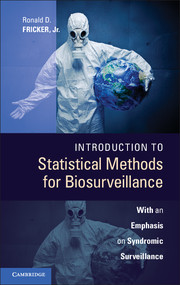Book contents
- Frontmatter
- Content
- Preface
- Acknowledgments
- Part I Introduction to Biosurveillance
- Part II Situational Awareness
- Part III Early Event Detection
- Part IV Putting It All Together
- Part V Appendices
- A A Brief Review of Probability, Random Variables, and Some Important Distributions
- B Simulating Biosurveillance Data
- C Tables
- References
- Author Index
A - A Brief Review of Probability, Random Variables, and Some Important Distributions
from Part V - Appendices
Published online by Cambridge University Press: 05 March 2013
- Frontmatter
- Content
- Preface
- Acknowledgments
- Part I Introduction to Biosurveillance
- Part II Situational Awareness
- Part III Early Event Detection
- Part IV Putting It All Together
- Part V Appendices
- A A Brief Review of Probability, Random Variables, and Some Important Distributions
- B Simulating Biosurveillance Data
- C Tables
- References
- Author Index
Summary
A pinch of probability is worth a pound of perhaps.
James Thurber (1984–1961)Much of this text assumes a working knowledge of probability, sometimes at a fairly advanced understanding and insight, and a basic facility with the mathematics of probability. For those who may require a refresher, this appendix provides a brief review of probability, including:
• Rules for calculating the probability of various simple and compound events;
• Conditional probability and independence of events;
• Random variables, including the concepts of expected value and variance;
• Important discrete and continuous probability distributions; and
• Sampling distributions, standard errors, and the Central Limit Theorem.
Why is probability important to biosurveillance? As the rest of the text hopefully makes clear, disease is stochastic, which means that the transmission and progression of a disease or an outbreak through a population is subject to chance: the chance encounters of people; the chance transmission of disease between people (and perhaps animals); the chance progression of disease within a person; and the chance treatment of disease, including whether and how any particular individual seeks treatment (or not).
- Type
- Chapter
- Information
- Introduction to Statistical Methods for BiosurveillanceWith an Emphasis on Syndromic Surveillance, pp. 305 - 334Publisher: Cambridge University PressPrint publication year: 2013



